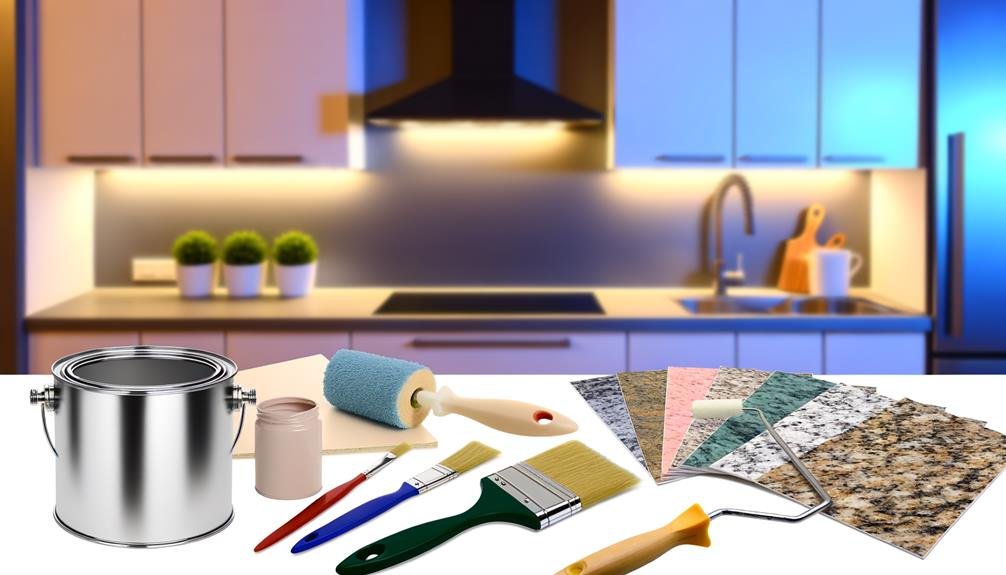Have you ever looked at your kitchen countertop and wondered if a splash of color could bring it back to life? As a professional writer with a focus on home improvement, I’ve explored numerous ways to rejuvenate interiors without breaking the bank.
Painting a kitchen countertop is indeed one such solution that has garnered attention for its affordability and transformative potential. It’s a tempting project, especially when you consider the variety of hues and finishes that can tailor your space to your personal taste.
Yet, before you grab a paintbrush and declare it a DIY day, it’s crucial to understand the intricacies involved. From selecting the right type of paint to the proper surface preparation, each step is pivotal in ensuring the result is both aesthetically pleasing and resilient to daily wear and tear.
Continue Reading to Understand These Key Points:
- Countertop painting is a cost-effective alternative to replacing countertops.
- It offers customization options with a variety of colors and patterns.
- DIY-friendly countertop paint kits are readily available in the market.
- Proper surface preparation, including cleaning, sanding, and priming, is crucial for a successful paint job.
Assessing Countertop Paintability
Before deciding to paint your kitchen countertop, it’s important to assess the material, whether it’s laminate, granite, Formica, or ceramic tile, to ensure it’s a suitable candidate for painting.
Laminate kitchen countertops are often the most receptive to a makeover with paint. When assessing countertop paintability, consider the surface condition; if it’s cracked or heavily damaged, painting mightn’t be the best option. The existing color and texture are important to note, as a primer that can effectively hide them is necessary.
Researching countertop paint kits that are compatible with my countertop’s material is essential. The right kit can make the process of priming and painting smoother, resulting in a more durable and visually appealing painted countertop.
After selecting the type of paint and primer designed for the material, apply them carefully. It’s crucial to let the primer dry completely before painting the laminate to avoid any issues that might compromise the finish.
Pros and Cons of Painting
When considering a kitchen update, painting your countertops offers a cost-effective and customizable solution, though it comes with its own set of challenges. Here’s a quick rundown of the pros and cons:
- Cost-Effective: Painting countertops is significantly cheaper than replacing them. A paint laminate can refresh your kitchen without breaking the bank.
- Customizable: You can choose any color or pattern that suits your taste, giving you complete control over the finished look.
- DIY Friendly: With countertop paint kits readily available, even those new to DIY can tackle this project. Just make sure to apply a good primer before the first coat and use painter’s tape to protect edges and walls.
- Durability: A well-executed painted surface, finished with a resin topcoat, can be surprisingly durable, although it’s not as tough as natural stone or untreated laminate.
Yet, there are drawbacks. The drying time between coats can be lengthy, and you’ll need to wait even longer before applying the final coat. The painted surface can’t handle hot pans, and if the prep work isn’t done right, you might face peeling or chipping.
It’s a delicate balance, but if you’re up for the challenge, the transformation can be impressive.
Choosing the Right Paint
Selecting the appropriate paint is crucial for ensuring your painted kitchen countertops are both attractive and durable. When I decided to give my countertops a new look, I knew I needed to choose the right paint for the job. After doing a bit of research, I learned that specific countertop paint kits are the way to go. These kits are designed to withstand the daily wear and tear of a kitchen environment.
One popular choice is the Giani countertop paint kit. It’s praised for its durability and how easy it is to use. Plus, it comes in a variety of styles and colors, allowing me to tailor the look to my kitchen’s aesthetic. I’ve read that Rustoleum countertop paint kits might not be the best choice due to potential peeling and chipping issues.
Before I start painting, I understand that it’s essential to follow the manufacturer’s instructions for my countertop material. Here’s a comparison table I put together:
| Paint Kit Brand | Durability | Ease of Use |
|---|---|---|
| Giani | High | Easy |
| Rustoleum | Low | Moderate |
| *Other Brand* | Moderate | Varies |
I’ll be using a roller to apply the primer and paint, ensuring a smooth, even finish. Taking the time to prep and choose the right paint will make all the difference in the final result.
Step-by-Step Kitchen Countertop Painting Guide
To ensure a successful countertop transformation, the first step is meticulously cleaning the surfaces with soap and water to remove all traces of grease and dirt. It’s especially crucial if you’re dealing with a laminate countertop, as it sets the stage for a smooth painting experience.
Here are the step-by-step instructions to guide you through:
- Sand the Countertop: After cleaning, I sand the surface to create a rough texture. This helps the primer and paint to adhere better, making the painted finish more durable. I make sure to clean the dust off thoroughly once I’m finished.
- Apply Primer: Using a foam brush, I carefully cut in around the edges of the countertops. For larger areas, a roller makes the job quicker and smoother. I let the primer dry for at least 4 hours before applying a second coat if needed.
- Paint the Countertop: Once the primer is dry, I apply the paint similarly. It’s essential to let each coat dry completely before adding another.
- Cure Time: Patience is critical – I don’t rush the drying process. The painted countertops should cure for a full 24 hours before they come into contact with anything, giving them a new and robust finish that resembles granite countertops.
Maintenance of Painted Countertops
Maintaining your painted countertops involves regular cleaning with a gentle soap solution to prevent the accumulation of dirt and grime. It’s been years since I applied primer and paint to my kitchen surfaces, and I’ve learned that consistent care is key to keeping my countertops looking their best. I use a soft cloth and a mixture of soap and water to wipe away any spills or marks. When the light hits the satin finish on my countertops, I want it to reflect a well-kept kitchen.
To preserve the integrity of the paint, I always use cutting boards and trivets, which protect the surface from scratches and heat. I steer clear of abrasive cleaners and harsh chemicals that could damage the beauty of the Giani marble kit. Instead, I stick to products that are safe for painted surfaces.
I also perform frequent inspections of the countertops to spot any signs of wear or chipping. Touch-ups are simple when I use the leftover Giani epoxy resin. Every so often, I apply a protective sealant to reinforce the durability of the finish.
Through diligent maintenance of painted countertops, I ensure that my kitchen remains as inviting and vibrant as it was on day one.
Are DIY Kitchen Countertop Solutions as Effective as Painting a Kitchen Countertop?
When deciding between diy countertop ideas and painting a kitchen countertop, it’s important to consider the desired result. While DIY solutions can be cost-effective and creative, they may not always offer the same durability and longevity as professionally painted countertops. It’s important to weigh the pros and cons before making a decision.
Final Thoughts
After weeks of research, I decided to take the plunge and paint my tired laminate countertops. I chose a granite-look paint kit for that high-end finish. The transformation was incredible, and the upkeep isn’t too demanding—just no hot pans directly on the surface.
My friend, inspired by my project, went for a sleek, solid color on her tile counters. We both agree, painting is a budget-friendly way to rejuvenate a kitchen, provided you’re diligent with the prep and follow-through.


Has anyone tried a different brand than what’s usually recommended for these paint kits? I’m wondering if the outcomes are really as varied as they say. Thinking of giving my old countertops a new life but don’t wanna end up worse than where I started.
I painted my kitchen countertops last summer using a kit I found online, and it completely transformed my baking space! So pleased with how it turned out. Highly recommend to anyone sitting on the fence about this.
painting countertops sounds like a disaster waiting to happen. why not just save and get new ones?
It’s crucial to select a paint that’s specifically designed for countertops to ensure durability and resistance to kitchen activities. Not all paints are created equal, and using the incorrect type can lead to unsatisfactory results that may require redoing sooner than expected. Research is key.
Thanks for the insight, TimTech! Any specific brands you’d recommend checking out?
TimTech is spot on. Quality matters, especially for a high-use area like countertops.
This is an interesting concept, but I wonder how well these painted countertops hold up over time with frequent use. Has anyone had issues with chipping or wear?
if I mess up the paint job, can I claim it’s modern art?